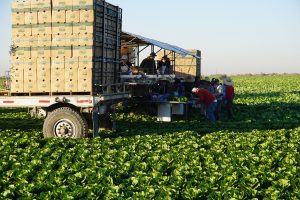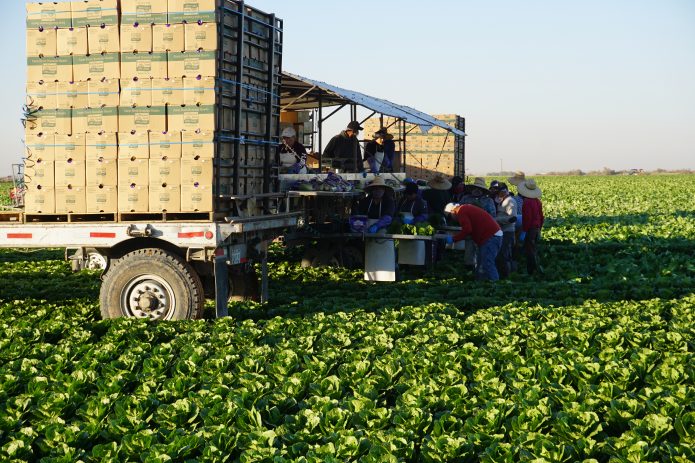
Crews harvest lettuce from an Imperial Valley field. The Farm Bill recently passed by the Senate and the House (and awaiting a signature from the White House) is a benefit to agriculture, but also could prove a benefit to the Salton Sea thanks to legislation by Sen. Diane Feinstein.
With the passage of the Federal Farm Bill by both the Senate and House (December 12 and 13 respectively) and approval from the White House, another opportunity has arisen to help fund restoration efforts at the Salton Sea. After the failure of Prop. 3 during the November election, which amounts to a $200 million loss for the sea, a spark of positive funding news is good to hear. While there is no guarantee of funding for the sea in the Farm Bill (nor is the sea even mentioned) there is a provision for environmental projects for which the sea could qualify for funding. And it appears the Salton Sea Authority is gearing up to pursue such funding—again should the President sign the bill.
Specifically, Sen. Diane Feinstein introduced drought legislation into the Farm Bill that could make the Salton Sea eligible for funding. One key point in favor of the sea receiving USDA funding through the legislation is that the USDA has previously awarded $7.5 million to the sea under the Regional Conservation Partnership Program. Under the Farm Bill, the USDA could expand that funding to the sea, according to a press release from the Salton Sea Authority (SSA).
That release from the SSA states that overall, the Farm Bill provides $6 billion in annual funding for conservation, but prior to the Feinstein legislation, the funding could not be used for projects in Imperial Irrigation District lands, like the Salton Sea exposed playa. However, under the legislation from Feinstein, that limitation was removed, providing an opportunity for funding habitat and air quality projects at the sea.
There continues to be a great deal at stake when it comes to the need to address restoration—separate from mitigation—at the Salton Sea. Restoration is a State responsibility and the State has made some strides to meet its obligations. However, the Federal government, a landowner at the sea, also has a role to play in the future of the sea, solidified by President Obama’s 2016 statements regarding the need to reverse the deterioration at the sea and the signing in that same year of a Memorandum of Understanding between the State and Federal governments, declaring their intentions to work in tandem on Salton Sea Management.
Movement toward a smaller but sustainable Salton Sea has begun. With more than $200 million in place thanks to an earlier water bond, the State is anticipating moving forward in 2019 with on-the-ground projects that represent the start of Phase One of the Salton Sea Management Program (SSMP), which ultimately will address some 30,000 acres of exposed playa over ten years. Additionally, the State is lining-up full-time dedicated project managers and engineers to move projects forward at a faster clip.
If the Federal government were to make funds available through the USDA and the Farm Bill, that would certainly help move restoration further and expand on the so-called partnership between the Federal and State governments. There certainly is reason to be hopeful that Sen. Feinstein’s efforts will prove a benefit to the Salton Sea. But hope will not be enough. When the Farm Bill is signed off by the White House, the real work begins of securing those funds for the sea, when likely there will be so many others seeking that similar pot of funds for other uses. What the sea has in its favor is that all eyes are focused on that particular body of water and its connection to other critical issues of both Federal and State importance. Only time will tell whether the Farm Bill opens the door to a new stream of funding to the sea. Regardless of the outcome, both the Federal and State governments must continue to act and work together to ensure a restoration program moves forward, and that the SSMP achieves its goals.
